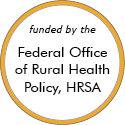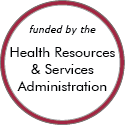Rural Project Examples: Populations
Promising Examples
Health without Borders


Updated/reviewed January 2025
- Need: To improve the health of communities in the south central region of New Mexico.
- Intervention: A program was developed to address diabetes prevention and control, behavioral healthcare, and immunization in Luna County.
- Results: During the program, 1,500 immunizations were distributed, baseline measurements of participants improved, and 935 new patients were seen for behavioral health issues.
Project C.A.R.E.
Updated/reviewed October 2024
- Need: There is a lack of dementia-specific support for rural caregivers.
- Intervention: Project C.A.R.E. was created to meet the needs of caregivers of those with Alzheimer's or other dementias, targeting rural North Carolina.
- Results: Under Project C.A.R.E., rural families receive information and referrals as well as individualized care consultation from dementia-trained family consultants.
Healthy Connections, Inc. Healthy Families Arkansas

Updated/reviewed December 2022
- Need: High poverty rates and lack of access to healthcare make caring for unborn and newborn children difficult for young mothers in Arkansas's Polk and Garland Counties.
- Intervention: An Arkansas-based program provides a national healthcare service to expectant and young mothers. Prenatal check-ups, education, transportation, well-baby checks and child immunizations are all provided by the Healthy Connections, Inc.
- Results: The program's results demonstrate an increase in first trimester prenatal care rates and child immunization rates, as well as a dramatic decrease in confirmed cases of child abuse.
Contingency Management Smoking Cessation in Appalachia
Updated/reviewed June 2022
- Need: To reduce smoking rates of pregnant women and adolescents in Appalachian regions of eastern Kentucky and Ohio.
- Intervention: A web-based smoking cessation program that offered monetary incentives to reducing smoking.
- Results: Participants significantly reduced smoking rates or quit altogether.
School-Based Health Center Dental Outreach

Updated/reviewed July 2020
- Need: To improve the oral health status of children ages 3 to 17 living in rural areas of Louisiana.
- Intervention: School-based nurse practitioners perform oral health assessments, apply fluoride varnishes when indicated, and make dental referrals, with completion rates of the latter tracked by dental case managers.
- Results: Significant numbers of school children are receiving oral health examinations, fluoride varnish applications, and receiving care coordination to improve numbers of completed dental appointments.
Youth4Health

Updated/reviewed December 2019
- Need: To educate youth about obesity and healthy lifestyle choices.
- Intervention: An educational program about healthy living was implemented in Lincoln and Claiborne Parishes in Louisiana for youth ages 9-18.
- Results: Youth4Health program produced greater awareness and participation in healthier lifestyles by target youth and their families, as well as church congregations.
Other Project Examples
Club Scrub
Updated/reviewed December 2025
- Need: Impact healthcare workforce shortages in rural Wisconsin.
- Intervention: The Rural Wisconsin Health Cooperative, leveraging evidence-informed grow-your-own pipeline activities to generate interest in health-related professions, partnered with the Wisconsin Office of Rural Health to create the Club Scrub program for 7th and 8th graders.
- Results: The original 2006-2007 program results revealed that participants gained a better understanding of career options in the healthcare industry and annual Club Scrub events continue to be sponsored by several Wisconsin rural healthcare delivery systems.
I-REACH (Improving Rural Enrollment, Access, and Healthcare in Rural Veterans)

Updated/reviewed November 2025
- Need: To improve veterans' access to healthcare in rural Michigan.
- Intervention: I-REACH connects veterans to healthcare services and other programs and helps healthcare facilities and providers become more veteran-friendly.
- Results: The program has received positive feedback from Veteran Service Officers in counties where there were outreach events.
Men's Conversation Group
Updated/reviewed November 2025
- Need: Suicide rates among men age 65 and older have been rising in North Carolina. Challenges include losing friends, illnesses, and the loss of independence – all of which can lead to isolation and depression.
- Intervention: Chatham County Aging Services of North Carolina started the Men's Conversation Group to connect retired men in need of male friends and mutual support.
- Results: Men in similar stages of life and varying backgrounds are forming friendships, engaging in activities, and taking care of their mental health.
One Health Recovery Doulas

Updated/reviewed November 2025
- Need: To support pregnant and parenting women with a history of substance use, mental health, or co-occurring disorders in rural areas of Montana.
- Intervention: One Health, a consortium of Federally Qualified Health Centers (FQHCs), developed a team of "recovery doulas" – individuals who are dual-certified as doulas and peer-support specialists. The One Health recovery doula program offers group and individual services to women and their partners from pregnancy through the first years of parenthood.
- Results: A team of four recovery doulas (or doulas-in-training) employed by One Health offer services in 8 rural eastern Montana counties. One Health has also successfully trained and certified 35 Peer Recovery Doulas statewide through their Peer Recovery Doula certification curriculum.
For examples from other sources, see:
